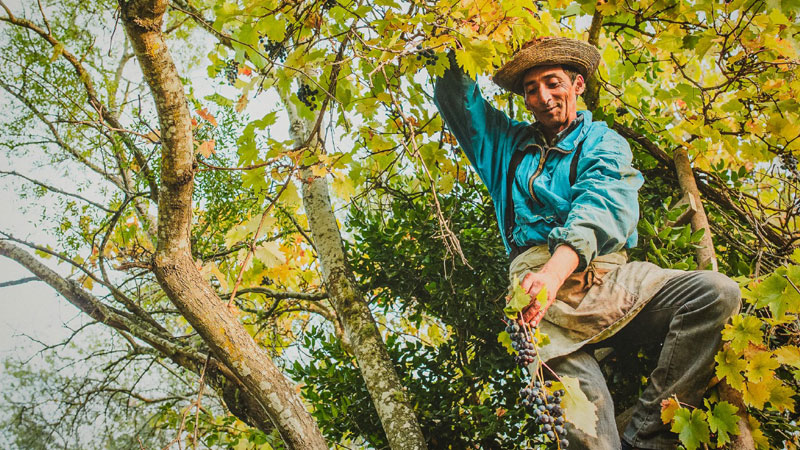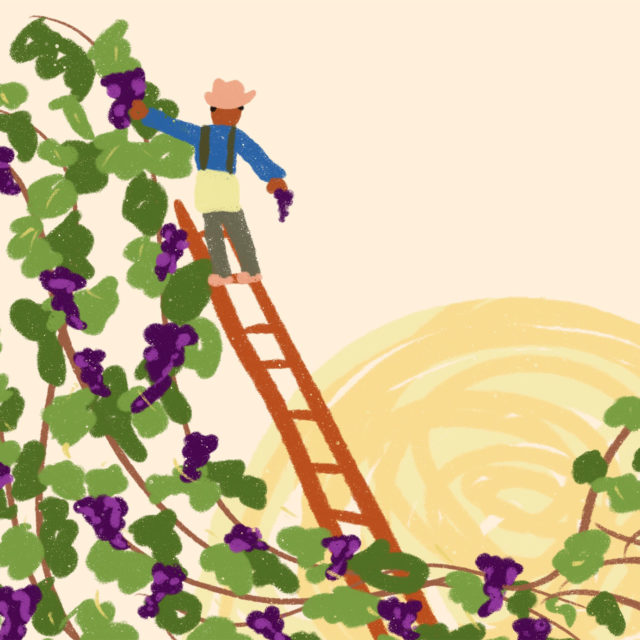In North America, it’s known as the Mission grape; in the Canary Islands, it’s Lístan Prieto. But in Chile the grape long dismissed or blended away is known as Pais, and it’s finally having its moment. The wine is light and crushable, similar in body to Gamay and Pinot Noir. The grape is much loved by somms as much for its drinkability as its history — Pais may just be the oldest varietal in the New World.
In Chile, Pais vines date back 200 to 300 years. At Bouchon Family Wines in Chile’s Maule Valley, some have gone wild, leaving their fine rows and entangling in a thicket of woods, twining into trees so that, to harvest this wild Pais, workers must climb a ladder into the overhead canopy.
“Pais came with the first Spaniards, with the conquistadores,” says Patricio Tapia, author of “Descorchados,” Chile’s renowned wine guide. “What we know now, genetically speaking, is that Pais is Lístan Prieto, a grape which is planted in the Canary Islands, which makes sense because, you know, the Spaniards stopped in Canary Islands to get food and stuff, and from the Canary Islands they came to the New World.”
Don't Miss A Drop
Get the latest in beer, wine, and cocktail culture sent straight to your inbox.Bringing Lístan Prieto with them, of course. “It was the first vine planted in the New World, in the Americas,” says Tapia. “It wasn’t Cabernet Sauvignon — it wasn’t Chardonnay for sure. We think that the Mission grape was the first planted in the U.S., and the Mission grape is the same as Pais, and Pais is Lístan Prieto.”
For centuries, Pais was Chile’s wine. Until it wasn’t.
From sometime in the 1500s until the second half of the 19th century, Pais was the main source of red wine in Chile. Then, in the second half of the 19th century, producers began importing French vines from Europe, like Cabernet Sauvignon and Merlot, and soon Pais was considered lesser, a second-class citizen, so to speak. Chilean winemakers added it to their blends, but never called attention to it. Pais became the wine of the people. It was called pipeño, meaning an everyday wine, one that’s stored in the family cellar and drunk at lunch with a tortilla, or at a rodeo.
Julio Bouchon, executive director of Bouchon Family Wines, had been steeped in Pais in his childhood. He’d just forgotten about it. “I remember my father making Pais in this old cement tank, and this is the wine we used to have,” Bouchon says. “I used to drink with my father and my grandfather at the table. It’s the taste I remember when I was a little kid.”
And yet, that wine of his childhood had been replaced by the drive for Bordeaux-style wines, for Cabernet Sauvignon and Merlot, which Chileans planted en masse in the 19th and 20th centuries. For 30 years, the taste of Pais was gone for Bouchon.
Rediscovering Pais
Yet one of Bouchon Family Wines’ estates, in the coastal dryland of Maule, was full of untended bush vines and dry-farmed Pais. In 2008, Julio was cleaning the wild parcels at the edge of the vineyard and the old bush vine Pais came out. And so, he began learning to make it.
In wine terms, if Bordeaux is big and extracted, Pais is light and Burgundian. First, he tried to make it in the cellar — to develop a rich extracted wine — then he tried rosé and even whites. Only when he began making it in the old way, with less intervention — harvested by hand, fermented with natural yeasts, and stored in cement vats, not oak barrels — did he learn to make a top-notch Pais.
Julio and his brother Juan began thinking they should do something with Pais. After all, it’s part of Chile’s history; it’s the beginning of Chilean viticulture. Plus, Pais does exceptionally well under the driest of conditions, like those of Chile’s Secano Interior and the Maule Valley and Itata. And so, they began making Pais again under the Bouchon label, releasing their first vintage in 2014.
“Do you think you can sell even one bottle of it?” Julio’s father asked him when they began. Today, under the J. Bouchon label, they make six wines from Pais, including a Pais Salvaje in red and white. To harvest that salvaje, or wild, workers literally have to climb into the trees, which is quite unusual in the wine world. They also make a sparkling Pais blend, and Pais Viejo, which is the best-selling among them in the U.S.

Searching for Pipeño, the Everyday Pais Wine
Meanwhile, back in the early 2000s, Louis-Antoine Luyt, a French sommelier turned winemaker in Chile, and the person credited with the revival of Pais, had begun chasing Pais across the country. From Santiago, he took the road to the south until he got to Maule where he began visiting small towns and vineyards. He went farther south, and to the west and to the east, and deeper and deeper in the countryside, clocking what he expects is 40,000 kilometers — about 25,000 miles — a year. He wanted to know the place, the regions, the small areas, and the people growing Pais and making pipeño, the rustic, classic style of Pais wines.
“It was an obsession, because each person has a different kind of vocabulary, the same approach but a different execution,” says Luyt. So, the wine in one place — the same small area where two or three or five people are using the same grapes — doesn’t show the same every time. “It is the perfect definition of terroir,” he says.
By 2007, Luyt had produced his first Pais and launched a Pais movement in Chile, landing it in restaurants across the world. His six Pais bottlings are among the most widely available and offer remarkable value, selling for around $20 apiece. The common refrain among somms has been: Where else in the world can you find a wine made from 200-year-old vines for around $20?
Heeding the Call of Pais
Another renowned Chilean winemaker, Roberto Henriquez, has also become known globally for his Pais. Henriquez felt a strong draw to the wines early in his career. “The vines, the terroir were talking to me,” he says. They were saying, “I am 200 years old. I am planted in basaltic, in granitic, in sedimentary, and in alluvial soil. I’m pre-phylloxeric. Why don’t you make wine with me?”
Working with Pais wasn’t just important to Chile, Henriquez believes, but also to the world, which has pretty much lost its Pais plants — to phylloxera in Europe — or otherwise forgotten it. “I think it’s really important for the world because the world can record old genetic materials that Europe lost in a moment,” he says of Pais.
For some of those reasons, Henriquez chooses to work with old ungrafted vines, without irrigation. It is, he explains, the classic viticulture. Plus, there was the fact that he believes Pais is exceptional at expressing its place. “With Pais, it’s really easy to express the terroir, or difference between the wines,” Henriquez says. Put a Pais from Maule, from Itata, and from Bío Bío in a glass and you don’t have to be a great taster to distinguish the differences, he says. “The first one is animal, the second one more red-fruited, the last one more herbal things.”
And so, Henriquez’s challenge has also been to change the perception of Pais, of old grapes, and old winemaking techniques. Which is what he and his cohorts like Luyt and Bouchon have begun to successfully do. Today, Pais can be found (often labeled Pipeño) everywhere from geeky wine bars, like Terroir in New York City, to gastronomic markets like Dopolavoro in downtown Los Angeles, to wine shops in northern Michigan like Burritt’s Market.
Pais, Off the Old Vines and in the Glass
If these winemakers share a common mission to return Pais to its proper place in the world of wine, they also share similar passions for Pais in the glass. Pais shows its identity best when it is treated with a light touch, Henriquez says. It may have its own identity, he argues, but it can easily compete with Pinot Noir, Trousseau, and Gamay — and win the palates of those who love such finessed wines.
Pais’s tension between simplicity and complexity is what Bouchon and Luyt admire about Pais. It’s light in color and body. “It looks like a pool party, like a glou glou wine,” Bouchon says. But it also has an intriguing textural element. “The combination of the rustic tannins of the Pais, together with the granitic soil, get you something super interesting,” he says.
